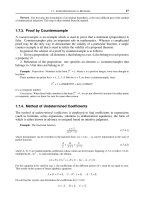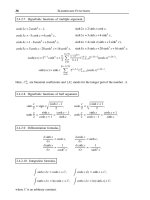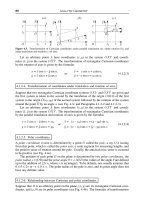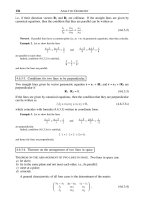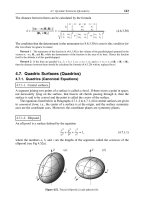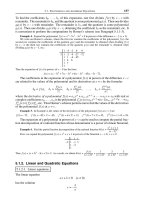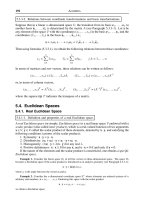Handbook of mathematics for engineers and scienteists part 133 pps
Bạn đang xem bản rút gọn của tài liệu. Xem và tải ngay bản đầy đủ của tài liệu tại đây (377.03 KB, 7 trang )
892 DIFFERENCE EQUATIONS AND OTHER FUNCTIONAL EQUATIONS
3
◦
. For equations with rational right-hand side
y(x + 1)–ay(x)=
b
x + c
,
where c ≥ 0 and a
[0, 1], a particular solution is written in the form of the integral
y(x)=b
1
0
λ
x+c–1
λ – a
dλ.
4
◦
. For the equation with exponential right-hand side
y(x + 1)–ay(x)=
n
k=0
b
k
e
λ
k
x
,
there is a particular solution of the form
y(x)=
⎧
⎪
⎪
⎪
⎪
⎨
⎪
⎪
⎪
⎪
⎩
n
k=0
b
k
e
λ
k
– a
e
λ
k
x
if a ≠ e
λ
m
,
b
m
xe
λ
m
(x–1)
+
n
k=0, k≠m
b
k
e
λ
k
– a
e
λ
k
x
if a = e
λ
m
,
where m = 0, 1, , n.
5
◦
. For the equation with sinusoidal right-hand side
y(x + 1)–ay(x)=b sin(βx),
there is a particular solution of the form
y(x)=
b
a
2
+ 1 – 2a cos β
(cos β – a)sin(βx)–sinβ cos(βx)
.
6
◦
. For the equation with cosine in the right-hand side
y(x + 1)–ay(x)=b cos(βx),
there is a particular solution of the form
y(x)=
b
a
2
+ 1 – 2a cos β
(cos β – a)cos(βx)+sinβ sin(βx)
.
17.2.1-6. Nonhomogeneous linear equations with the right-hand side of general form.
1
◦
. Consider equation (17.2.1.18) whose right-hand side is an analytic function that admits
the expansion in power series:
g(x)=
∞
k=0
a
k
x
k
,(17.2.1.20)
which converges on the entire complex plane (it follows that lim
k→∞
|a
k
|
1/k
= 0). If
lim
k→∞
k! |a
k
|
1/k
< 2π,(17.2.1.21)
then the solution of equation (17.2.1.18) can be represented as a convergent series
y(x)=
∞
k=0
a
k
k + 1
B
k+1
(x),
where B
k
(x) are Bernoulli polynomials (see Paragraph 17.2.1-5, Item 1
◦
).
Below we state a more general result that requires no conditions of the type (17.2.1.21).
17.2. LINEAR DIFFERENCE EQUATIONS WITH A SINGLE CONTINUOUS VARIABLE 893
2
◦
. Suppose that the right-hand side of equation (17.2.1.18) is an analytic function admit-
ting expansion by power series (17.2.1.20) convergent on the entire complex plane (such
functions are called entire functions). In this case, the solution of equation (17.2.1.18) can
be represented in the form
y(x)=
∞
k=0
a
k
β
k
(x),
where β
k
(x) are Hurwitz functions,defined by
β
k
(x)=
k!
2πi
|t|=1
(e
tx
– 1) dt
(e
t
– 1)t
k+1
+ k!
k
s=–k, s≠0
e
2isπx
– 1
(2isπ)
s+1
= P
k+1
(x)+Θ
k
(x),
P
n+1
(x) is a polynomial of degree n +1, Θ
k
(x) is an entire 1-periodic function, |t| = 1 is the
unit circle, and i
2
=–1.
17.2.1-7. Nonhomogeneous linear difference equations. Cauchy’s problem.
1
◦
. Consider the Cauchy problem for a nonhomogeneous linear difference equation of
special form (17.2.1.18) with the initial condition (17.2.1.10), where g(x) is a continuous
function defined for x ≥ 0,andϕ(x) is a given continuous function defined on the segment
0 ≤ x ≤ 1.
In order to find a solution of this Cauchy problem, the step method can be used: on the
interval 1 ≤ x < 2 one constructs a solution from equation (17.2.1.18) and the boundary
condition (17.2.1.10); on the interval 2 ≤ x < 3, one uses equation (17.2.1.18) and the
solution obtained for 1 ≤ x < 2; on the interval 3 ≤ x < 4, one uses equation (17.2.1.18) and
the solution obtained for 2 ≤ x < 3, etc. As a result, we have
y(x)=ϕ(x – n)+g(x – n)+g(x – n + 1)+···+ g(x – 1), n ≤ x < n + 1
,(17.2.1.22)
where n = 1, 2,
Solution (17.2.1.22) is continuous if it is continuous at integer points x = 1, 2, ,and
this leads us to the condition
ϕ(1)=ϕ(0)+g(0). (17.2.1.23)
The solution is continuously differentiable if the functions g(x)andϕ(x) are continuously
differentiable and, together with (17.2.1.23), the additional condition
ϕ
(1)=ϕ
(0)+g
(0)
for the corresponding one-sided derivatives is satisfied.
2
◦
. In a similar way, one considers the Cauchy problem for a nonhomogeneous linear
difference equation of general form (17.2.1.15) with the initial condition (17.2.1.10). As a
result, we obtain a solution of the form
y(x)=ϕ({x})
[x]
j=1
f(x – j)+
[x]
i=1
g(x – i)
i–1
j=1
f(x – j),
where [x]and{x} denote, respectively, the integer and the fractional parts of x (x =
[x]+{x}); the product and the sum over the empty index set (for [x]=0) are assumed equal
to 1 and 0, respectively.
894 DIFFERENCE EQUATIONS AND OTHER FUNCTIONAL EQUATIONS
If anontrivial particularsolution y
1
(x) of the homogeneous equation (17.2.1.1) isknown,
then the solution of the Cauchy problem for the nonhomogeneous equation (17.2.1.15) with
the initial condition (17.2.1.10) is given by
y(x)=y
1
(x)
ϕ({x})
y
1
(0)
+
[x]
i=1
g(x – i)
y
1
(x – i + 1)
.
17.2.2. Second-Order Linear Difference Equations with Integer
Differences
17.2.2-1. Linear homogeneous difference equations with constant coefficients.
A second-order homogeneous linear integer-difference equation with constant coefficients
has the form
ay(x + 2)+by(x + 1)+cy(x)=0, ac ≠ 0.(17.2.2.1)
This equation has the trivial solution y(x) ≡ 0.
The general solution of the difference equation (17.2.2.1) is determined by the roots of
the characteristic equation
aλ
2
+ bλ + c = 0.(17.2.2.2)
1
◦
.Forb
2
– 4ac > 0, the quadratic equation (17.2.2.2) has two distinct roots:
λ
1
=
–b +
√
b
2
– 4ac
2a
, λ
2
=
–b –
√
b
2
– 4ac
2a
.
The general solution of the difference equation (17.2.2.1) is given by
y(x)=Θ
1
(x)λ
x
1
+ Θ
2
(x)λ
x
2
if ab < 0, ac > 0;
y(x)=Θ
1
(x)λ
x
1
+ Θ
2
(x)|λ
2
|
x
cos(πx)ifac < 0;
y(x)=Θ
1
(x)|λ
1
|
x
cos(πx)+Θ
2
(x)|λ
2
|
x
cos(πx)ifab > 0, ac > 0,
(17.2.2.3)
where Θ
1
(x)andΘ
2
(x) are arbitrary 1-periodic functions, Θ
k
(x)=Θ
k
(x + 1), k = 1, 2.
2
◦
.Forb
2
– 4ac = 0, the quadratic equation (17.2.2.2) has one double real root
λ =–
b
2a
,
and the general solution of the difference equation (17.2.2.1) is given by
y =
Θ
1
(x)+xΘ
2
(x)
λ
x
if ab < 0,
y =
Θ
1
(x)+xΘ
2
(x)
|λ|
x
cos(πx)ifab > 0.
(17.2.2.4)
3
◦
.Forb
2
– 4ac < 0, the quadratic equation (17.2.2.2) has two complex conjugate roots
λ
1,2
= ρ(cos β i sin β), ρ =
c
a
, β = arccos
–
b
2
√
ac
,
and the general solution of the difference equation (17.2.2.1) has the form
y = Θ
1
(x)ρ
x
cos(βx)+Θ
2
(x)ρ
x
sin(βx), (17.2.2.5)
where Θ
1
(x)andΘ
2
(x) are arbitrary 1-periodic functions.
17.2. LINEAR DIFFERENCE EQUATIONS WITH A SINGLE CONTINUOUS VARIABLE 895
17.2.2-2. Linear nonhomogeneous difference equations with constant coefficients.
1
◦
. A second-order nonhomogeneous linear integer-difference equation with constant co-
efficients has the form
ay(x + 2)+by(x + 1)+cy(x)=f(x), ac ≠ 0.(17.2.2.6)
Let y
1
(x)andy
2
(x) be two particular solutions of the homogeneous equation (17.2.2.1).
According to the roots of the characteristic equation (17.2.2.2), these solutions are defined
by (17.2.2.3)–(17.2.2.5), respectively, with Θ
1
(x) ≡ 1, Θ
2
(x) ≡ 0 and Θ
1
(x) ≡ 0, Θ
2
(x) ≡ 1.
A particular solution of the nonhomogeneous equation (17.2.2.6) satisfying zero initial
conditions
y(x)=0, y(x + 1)=0 for 0 ≤ x < 1
has the form
y(x)=
1
a
[x]–1
j=1
Δ(x – j, x)
Δ(x – j, x – j + 1)
f(x – j), Δ(x, z)=
y
1
(x) y
2
(x)
y
1
(z) y
2
(z)
.(17.2.2.7)
2
◦
. The solution of the Cauchy problem for the nonhomogeneous equation (17.2.2.6) with
arbitrary initial conditions
y(x)=ϕ(x), y(x + 1)=ψ(x)for0 ≤ x < 1 (17.2.2.8)
is the sum of the particular solution (17.2.2.7) and the function
u(x)=–
1
Δ({x}, {x} + 1)
0 y
1
(x) y
2
(x)
ϕ({x}) y
1
({x}) y
2
({x})
ψ({x}) y
1
({x} + 1) y
2
({x} + 1)
,
which is a solution of the homogeneous equation (17.2.2.1) with the initial conditions
(17.2.2.8).
17.2.2-3. Linear homogeneous difference equations with variable coefficients.
1
◦
.Asecond-order linear homogeneous integer-difference equation has the form
a(x)y(x + 2)+b(x)y(x + 1)+c(x)y(x)=0, a(x)c(x)
0.(17.2.2.9)
The trivial solution, y(x)=0, is a particular solution of the homogeneous linear equation.
Let y
1
(x), y
2
(x) be two particular solutions of equation (17.2.2.9) with the condition*
D(x) ≡ y
1
(x)y
2
(x + 1)–y
2
(x)y
1
(x + 1) ≠ 0.(17.2.2.10)
Then the general solution of equation (17.2.2.9) is given by
y(x)=Θ
1
(x)y
1
(x)+Θ
2
(x)y
2
(x), (17.2.2.11)
where Θ
1
(x)andΘ
2
(x) are arbitrary 1-periodic functions, Θ
1,2
(x)=Θ
1,2
(x + 1).
* Condition (17.2.2.10) may be violated at singular points of equation (17.2.2.9); for details see Para-
graph 17.2.3-3.
896 DIFFERENCE EQUATIONS AND OTHER FUNCTIONAL EQUATIONS
2
◦
.Lety
0
(x) be a nontrivial particular solution of equation (17.2.2.9). Then the substitution
y(x)=y
0
(x)u(x)(17.2.2.12)
results in the equation
a(x)y
0
(x + 2)u(x + 2)+b(x)y
0
(x + 1)u(x + 1)+c(x)y
0
(x)u(x)=0.(17.2.2.13)
Taking into account that y
0
(x) satisfies equation (17.2.2.9), let us substitute the expression
b(x)y
0
(x + 1)=–a(x)y
0
(x + 2)–c(x)y
0
(x)
into (17.2.2.13). Then, after simple transformations, we obtain
a(x)y
0
(x + 2)[u(x + 2)–u(x + 1)] – c(x)y
0
(x)[u(x + 1)–u(x)] = 0.
Introducing a new variable by
w(x)=u(x + 1)–u(x)(17.2.2.14)
we come to the first-order difference equation
a(x)y
0
(x + 2)w(x + 1)–c(x)y
0
(x)w(x)=0.
After solving this equation, one solves the nonhomogeneous first-order equation with
constant coefficients (17.2.2.14), and then, using (17.2.2.12), one finds a solution of the
original equation.
17.2.2-4. Linear nonhomogeneous difference equations with variable coefficients.
1
◦
.Asecond-order linear nonhomogeneous difference equation with integer differences
has the form
a(x)y(x + 2)+b(x)y(x + 1)+c(x)y(x)=f(x), a(x)c(x)
0.(17.2.2.15)
The general solution of the nonhomogeneous equation (17.2.2.15) is given by the sum
y(x)=u(x)+y(x),
where u(x) is the general solution of the corresponding homogeneous equation (with f ≡ 0),
and y(x) is a particular solution of equation (17.2.2.15). The general solution of the
homogeneous equation is defined by the right-hand side of (17.2.2.11).
Every solution of equation (17.2.2.15) is uniquely determined by given values of the
sought function on the interval [0, 2).
2
◦
. A particular solution y(x) of the linear nonhomogeneous difference equation
a(x)y(x + 2)+b(x)y(x + 1)+c(x)y(x)=
n
k=1
f
k
(x)
can be represented by the sum
y(x)=
n
k=1
y
k
(x),
17.2. LINEAR DIFFERENCE EQUATIONS WITH A SINGLE CONTINUOUS VARIABLE 897
where y
k
(x) are particular solutions of the linear nonhomogeneous difference equations
a(x)y
k
(x + 2)+b(x)y
k
(x + 1)+c(x)y
k
(x)=f
k
(x).
3
◦
.Lety
1
(x)andy
2
(x) be particular solutions of the corresponding linear homogeneous
equation (17.2.2.9) that satisfy the condition (17.2.2.10). A particular solution of the linear
nonhomogeneous equation (17.2.2.15) can be sought in the form
y(x)=ϕ
1
(x)y
1
(x)+ϕ
2
(x)y
2
(x), (17.2.2.16)
where ϕ
1
(x)andϕ
2
(x) are functions to be determined.
For what follows, we need the identity
Δ[ϕ(x)ψ(x)] ≡ ψ(x + 1)Δϕ(x)+ϕ(x)Δψ(x), (17.2.2.17)
where Δϕ(x) is the standard notation for the difference,
Δϕ(x) ≡ ϕ(x + 1)–ϕ(x).
From (17.2.2.16), using the identity (17.2.2.17), we obtain
Δy(x)=y
1
(x + 1)Δϕ
1
(x)+y
2
(x + 1)Δϕ
2
(x)+ϕ
1
(x)Δy
1
(x)+ϕ
2
(x)Δy
2
(x). (17.2.2.18)
As one of the equations to determine the functions ϕ
1
(x)andϕ
2
(x)wetake
y
1
(x + 1)Δϕ
1
(x)+y
2
(x + 1)Δϕ
2
(x)=0.(17.2.2.19)
In view of the above considerations, from (17.2.2.16) and (17.2.2.18) we find that
y(x + 1)=ϕ
1
(x)y
1
(x + 1)+ϕ
2
(x)y
2
(x + 1),
y(x + 2)=ϕ
1
(x + 1)y
1
(x + 2)+ϕ
2
(x + 1)y
2
(x + 2)
= ϕ
1
(x)y
1
(x + 2)+ϕ
2
(x)y
2
(x + 2)+y
1
(x + 2)Δϕ
1
(x)+y
2
(x + 2)Δϕ
2
(x),
(17.2.2.20)
where the second relation is obtained from the first one by replacing x with x + 1.
Substituting (17.2.2.16) and (17.2.2.20) into equation (17.2.2.15) andtaking into account
that y
1
(x)andy
2
(x) are particular solutions of the linear homogeneous equation (17.2.2.9),
we obtain
y
1
(x + 2)Δϕ
1
(x)+y
2
(x + 2)Δϕ
2
(x)=f(x)/a(x). (17.2.2.21)
Relations (17.2.2.19) and (17.2.2.21) form a system of linear algebraic equations for the
differences Δϕ
1
(x)andΔϕ
2
(x). The solution of this system has the form
Δϕ
1
(x)=–
f(x)y
2
(x + 1)
a(x)D(x + 1)
, Δϕ
2
(x)=–
f(x)y
1
(x + 1)
a(x)D(x + 1)
,(17.2.2.22)
where D(x) is the determinant introduced in (17.2.2.10).
Thus, the construction of a particular solution of the second-order nonhomogeneous
equation (17.2.2.15) amounts to finding a solution of two independent nonhomogeneous
first-order equations (17.2.2.22) considered in detail in Paragraphs 17.2.1-4–17.2.1-7.
4
◦
. The structure of particular solutions of second-order difference equations with spe-
cific (polynomial, exponential, sinusoidal, etc.) right-hand sides is described in Para-
graph 17.2.3-2.
898 DIFFERENCE EQUATIONS AND OTHER FUNCTIONAL EQUATIONS
17.2.3. Linear mth-Order Difference Equations with Integer
Differences
17.2.3-1. Linear homogeneous difference equations with constant coefficients.
An mth-order linear integer-difference homogeneous equation with constant coefficients
has the form
a
m
y(x + m)+a
m–1
y(x + m – 1)+···+ a
1
y(x + 1)+a
0
y(x)=0,(17.2.3.1)
where a
0
a
m
0.
Let us write out its characteristic equation,
a
m
λ
m
+ a
m–1
λ
m–1
+ ···+ a
1
λ + a
0
= 0.(17.2.3.2)
Consider the following cases:
1
◦
. All roots λ
1
, λ
2
, , λ
n
of equation (17.2.3.2) are real and mutually distinct. Then the
general solution of the original equation (17.2.3.1) has the form
y(x)=Θ
1
(x)λ
x
1
+ Θ
2
(x)λ
x
2
+ ···+ Θ
n
(x)λ
x
n
,(17.2.3.3)
where Θ
1
(x), Θ
2
(x), , Θ
n
(x) are arbitrary 1-periodic functions, Θ
k
(x)=Θ
k
(x + 1),
k = 1, 2, , n.
For Θ
k
(x) ≡ C
k
, formula (17.2.3.3) yields the particular solution
y(x)=C
1
λ
x
1
+ C
2
λ
x
2
+ ···+ C
n
λ
x
n
,
where C
1
, C
2
, , C
n
are arbitrary constants.
2
◦
.Therearek equal real roots: λ
1
= λ
2
= ···= λ
k
(k ≤ m), and the other roots are real and
mutually distinct. In this case, the solution of the difference equation (17.2.3.1) is defined
by
y =
Θ
1
(x)+xΘ
2
(x)+···+ x
k–1
Θ
k
(x)
λ
x
1
+ Θ
k+1
(x)λ
x
k+1
+ Θ
k+2
(x)λ
x
k+2
+ ···+ Θ
m
(x)λ
x
m
.
(17.2.3.4)
3
◦
.Therearek equal complex conjugate roots: λ = ρ(cos β i sin β)(2k ≤ m), and the
other roots are real and mutually distinct. In this case, for Θ
n
(x) ≡ const
n
the solution of
the functional equation has the form
y = ρ
x
cos(βx)(A
1
+ A
2
x + ···+ A
k
x
k–1
)+
+ ρ
x
sin(βx)(B
1
+ B
2
x + ···+ B
k
x
k–1
)+
+ C
2k+1
λ
x
2k+1
+ C
2k+2
λ
x
2k+2
+ ···+ C
m
λ
x
m
,
where A
1
, , A
k
, B
1
, , B
k
, C
2k+1
, , C
m
are arbitrary constants. In the general case,
the arbitrary constants involved in this solution should be replaced by arbitrary 1-periodic
functions.
4
◦
. In a similar way, one can consider the general situation.



